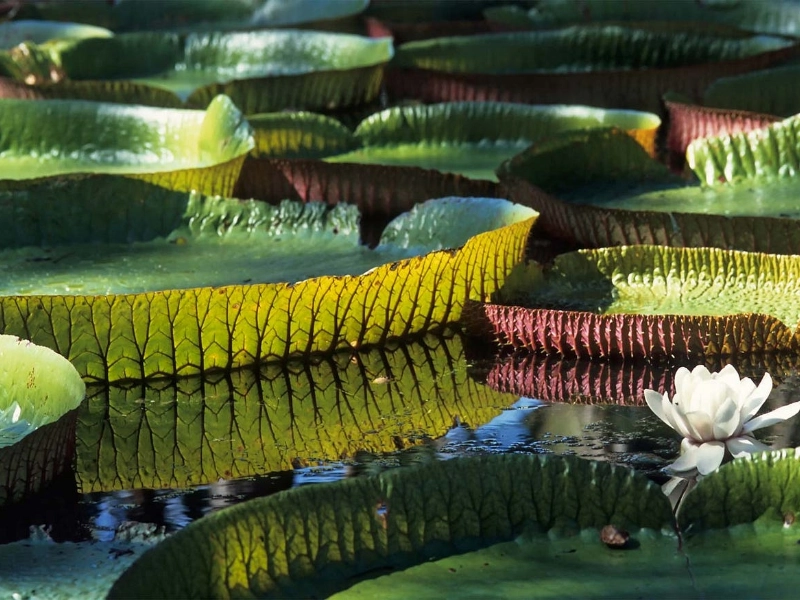The Eight Weirdest and Coolest Flowers in the World
Advertisement
4. Water Lilies and Lily Pads: The Aquatic Beauties with a Fierce Side

Advertisement
With their brilliant blossoms and famous floating leaves, or lily pads, water lilies (Nymphaeaceae family) are among the most identifiable and cherished aquatic plants gracing ponds, lakes, and slow-moving rivers all around. For millennia, these plants have enthralled people; they are often seen in art, literature, and cultural iconography. But under their calm and elegant appearance, the aquatic plant world is fiercely competitive.
Angiosperms—that is, flowering plants—water lilies have evolved to flourish in watery habitats. Rooted in the muck at the bottom of water bodies, their leaves and blossoms float on or emerge above the surface of the water. This modification lets them get the nutrients in the silt as well as the sunlight needed for photosynthesis.
With their great variety of colors—white, pink, yellow, and blue—the blossoms of water lilies are really remarkable. Some species, such as the night-blooming water lilies, open their blossoms in the evening and close them by mid-morning, therefore creating a mystery about their appeal. These blossoms are not only lovely but also quite effective reproductive structures. Protogynous, or female parts of many water lily species mature before male parts. Cross-pollination and genetic variety are encouraged by this approach.
Marvels of natural engineering, Lily pads—the floating leaves of water lilies—have Their big surface area lets them effectively gather sunlight for photosynthesis. Whereas the underside of the leaf has a network of air pockets that gives buoyancy, the top surface is covered in a waxy cuticle that resists water. This arrangement not only helps the leaf float but also facilitates atmospheric gas exchange.
Native to the Amazon River region, the enormous water lily (Victoria amazonica) is among the most remarkable members of the water lily family. Strong enough to hold the weight of a small child, these species generates leaves with a diameter of up to three meters (approximately ten feet). Measuring up to 40 centimetres (16 inches) in diameter and shifting colour from white to pink over two nights, the Victoria amazonica's blossoms are equally remarkable.
Water lilies are fierce rivals in aquatic environments even with their delicate look. Often outcompeting other aquatic vegetation, they are well-known for their quick colonising of suitable settings. Their big floating leaves change the aquatic environment by forming dense mats on the surface of the water that shade submerged plants. When water lilies are introduced to non-native environments, their fast expansion might occasionally cause them to be seen as invading species.
Water lilies' interaction with other floating plants especially reveals their competitive character. Their wide leaves efficiently eradicate other species, therefore monopolising the accessible surface area and sunlight. From water chemistry to fish numbers, this dominance can have major effects on aquatic ecosystems.
Still, water lilies are quite significant for ecology in their natural environments. While their flowers draw and assist different pollinators, their leaves give fish and amphibians cover and places for reproduction. Through their absorption of surplus nutrients, the plants also help stabilise sediments and enhance water quality.
Water lilies have had great symbolic value in human society across several civilisations. Actually a water lily, the blue lotus was connected in ancient Egypt with the sun and rejuvenation. Particularly strongly associated with water lilies, the lotus flower represents purity, enlightenment, and rebirth in Hinduism and Buddhism. Water lilies, most famously in Claude Monet's series of over 250 oil paintings showing his flower garden at Giverny, have also had a profound impact on Western art.
Water lilies remain a favourite in decorative ponds and water gardens today. Many cultivars created by horticulturists provide a great spectrum of floral colours and sizes to fit different aesthetic tastes. To prevent ecological disturbance, gardeners are encouraged, meanwhile, to use native plants or exercise caution with possibly invasive variants.
Finally, water lilies and their lily pads show an amazing junction of ecological influence, adaptation, and beauty. Their aggressive growth tactics and capacity to flourish in watery surroundings make them both appreciated ornamentals and possible ecosystem engineers. These aquatic wonders remind us of the intricate interactions in natural systems and the careful equilibrium needed for ecological harmony as we keep learning about and enjoying them.
You May Like
Advertisement

